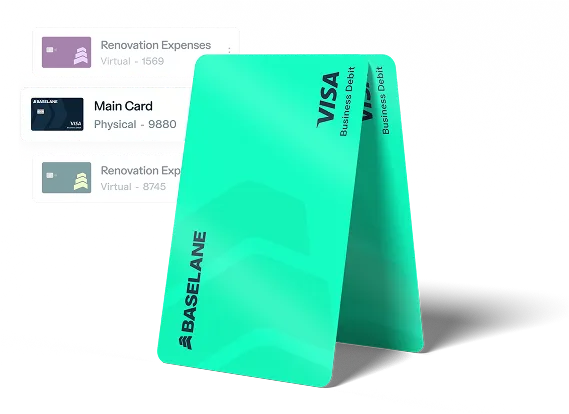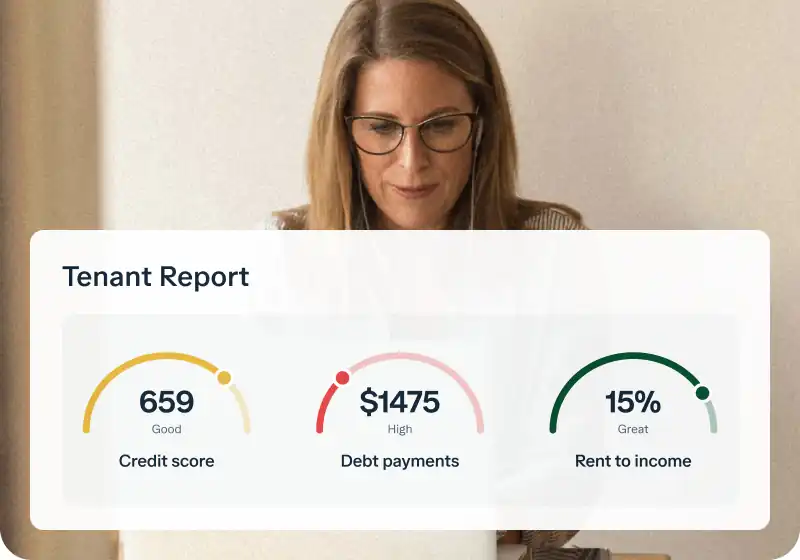Collecting rent can be a fragmented and time-consuming process, especially when managing tenants across multiple properties. Tracking payments, chasing late rent, and maintaining consistent cash flow often turns property managers into accountants, diverting time that could be spent on portfolio growth.
The solution lies in automating this process with Automated Clearing House (ACH) direct deposit. This guide will provide you with all the essential information about ACH direct deposits, including setup instructions, to help you modernize your rent collection in 2025.
Key takeaways
- ACH is the definitive method for modern rent collection, balancing high security with low transaction costs.
- It significantly improves cash flow predictability by automating recurring tenant payments, reducing late or missed rent payments.
- ACH transactions are vastly more cost-effective than credit card fees, increasing your net rental income.
- An integrated banking solution, like Baselane, combines ACH rent collection with automated bookkeeping, eliminates manual crunching, and saves time.
What is ACH direct deposit, and how the network works
An ACH direct deposit is an electronic transfer of funds moved directly between bank accounts via the Automated Clearing House (ACH) network. This vast, secure system is overseen by Nacha (National Automated Clearing House Association) and is responsible for the movement of virtually all electronic payments in the U.S., from payroll to bill payments.
ACH deposits are essentially digital checks—they are low-cost, high-volume transactions that eliminate the need for paper, postage, or manual trips to the bank.
How does the ACH direct deposit work?
The ACH direct deposit works based on the ACH network that operates on a structured, batch-processing system:
- Originating Depository Financial Institution (ODFI): This is your bank or payment processor that initiates the transfer on your behalf.
- Receiving Depository Financial Institution (RDFI): This is the tenant's bank that receives the instruction to debit the funds.
The structured process ensures transparency and compliance with every rent payment.
How long does ACH direct deposit take?
Typically, the ACH process takes between 1-3 business days to settle and for the funds to become available in your account.
This processing time is due to the nature of the ACH network, which operates on a structured, batch-processing system. However, the time can vary based on a few factors:
- Same-Day ACH: Same-Day ACH is becoming increasingly available, which can speed up the settlement significantly, often within hours.
- Platform speed: Advanced solutions often offer expedited processing times. For instance, platforms like Baselane can deposit payments in as little as two to five days.
- Weekends and holidays: The ACH network does not process transactions on weekends or federal holidays, which can extend the time it takes for a payment to clear.
Benefits of using ACH direct deposit for collecting rent
For a landlord prioritizing returns and low operational lift, the advantages of ACH are clear and directly impact your bottom line.
Cost efficiency
ACH transactions are universally the most cost-effective way to collect rent. These payments are processed in batches, making them significantly cheaper than other payment methods—often up to 70% less expensive than the high percentage fees associated with credit or debit card processing.
Modern banking solutions, like Baselane, even waive the ACH deposit fees for both you and your tenants (when depositing into a Baselane account), bringing transaction fees to negligible.
Enhanced security
ACH transactions occur directly between banking institutions or platforms, which provides a higher level of security than handling physical instruments like checks. As these payments are governed by rules set by Nacha, they tend to be more secure and come with less risk of lost or stolen payments.
Convenience & automation
You can set up recurring, automatic monthly rent debits once, eliminating the need for monthly invoicing or manual payment reminders. By automating the collection, tracking, and reconciliation process, you free up valuable time to focus on sourcing new deals or managing capital improvements.
Improved cash flow management
Automated payments lead to fewer missed payments and a more consistent, reliable stream of rental income. When combined with a platform offering a high-yield savings account, your collected rent funds immediately start earning up to [v="apyvalue"] APY² while they sit, further maximizing your returns.
How to receive rent payment via ACH transfer
- Authorization: The tenant grants explicit permission to you or your payment processor (the originator) to debit the rent amount from their bank account on a specific date.
- Initiation: You, the landlord (or your software), initiate the payment request through the ODFI, specifying the amount and due date.
- Transmission & Validation: The payment request is sent through the ACH network in batches to the RDFI. The tenant's bank verifies the account details and checks for sufficient funds.
- Settlement & Confirmation: Once verified, the funds are transferred and settled in your business account, typically within a few days.
- Posting to Accounts: Your integrated platform records the payment as income, associating it with the correct property and financial category.
ACH direct deposit vs. other payment methods
Let’s see how ACH direct deposits stack up against other payment methods for collecting rent.
Paper checks
While familiar, checks are the nemesis of efficient portfolio management.
- Inefficiencies: Checks require manual processing, postal delays, bank trips, and manual data entry into your bookkeeping system.
- Risks: They expose you to the risk of loss, fraud, and non-sufficient funds (NSF) fees if the check bounces.
Credit/Debit cards
Card payments are convenient for the tenant but can be costly for you. The biggest drawback is the percentage fee (typically 2.5% to 3.5% or more) that eats into your monthly profit. Imagine paying 3% fee, i.e., $45 for a $1,500 rent payment— straight out of your pocket.
Cards also carry a risk of chargebacks, which can leave you without payment and tied up in a dispute process.
Peer-to-Peer payment apps (P2P)
P2P apps like Zelle and Venmo are excellent for informal transfers but fall short for recurring rent collection. These apps are not designed for formal, recurring landlord-tenant transactions and often lack the smart bookkeeping and reporting features you need to file taxes properly.
Many of the P2P apps need manual initiation or lack integrated tracking that separates personal funds from business income, leading to commingling.
Comparison table: ACH direct deposit vs. other payment methods
ACH direct deposit fees and management
ACH fees typically come in two models:
- Per-transaction fee: A flat, low fee per payment, usually ranging from $0.25 to $1.50 per transaction. This is the most common model offered by rent collection software and dedicated payment processors.
- Subscription/Monthly fee: Some all-in-one property management software waive the per-transaction fee but require a monthly subscription fee, pricing for which can range widely.
The impact of absorbing vs. passing fees to tenants
The business decision comes down to who pays the fee:
- Passing the fee to tenants: You charge the tenant for the ACH transaction fee. While this preserves your margins, surveys show tenants highly prefer not to pay extra processing fees.
- Absorbing the fee: You pay the minimal transaction cost yourself. This significantly improves tenant satisfaction and makes your property more competitive, especially when the fee is effectively $0, as with Baselane.
How to set up ACH direct deposits?
Step 1: Choose your banking platform
You have two main avenues for setting up ACH direct bank deposits
Work directly with your bank
This is the traditional route, which often involves submitting physical forms and manual setup, and is not tailored to the needs of rent collection. It lacks automated authorization and integrated tracking.
Use an integrated banking platform
This is the recommended choice. Baselane is one such platform, built specifically for real estate investors and landlords like you. It's an integrated platform that combines banking, bookkeeping, and rent collection. You can collect rent via ACH for a $2 fee (waivable), manage late payments, and tag rent payments to a specific property or category.
For example, if you manage two units and three tenants, you can invite each of them to pay via ACH. You'll see an audit trail of the rent payments and can tag them to a specific unit and the Schedule E category, 'Rents received.' This way, you won't need to manually track rent or scramble through receipts when tax season arrives.

Step 2: Open your account and invite tenants
Opening an account, whether with a traditional bank or a banking platform like Baselane, typically involves similar steps. However, the latter offers greater convenience and speed.
Here’s how to open your account with Baselane and start receiving rent payments via ACH.
- Sign up for Baselane: Create your account using your email address and a password.
- Open your account: Once in, choose the entity type (LLC or sole proprietorship), upload your documents (address proof, identity proof, and business details), and submit.
- Configure payments: Click on the Rent Collection tab and set up the property, rent amount, due date, and specify which dedicated checking or high-yield savings account will receive the deposit.
- Invite tenant(s): Send the invitation to the tenant directly through the platform. Tenants will also get access to a dedicated dashboard to track payments on their end.
Read more about how to set up ACH payments for rent
Automate rent collection with ACH deposits
ACH direct deposit is the single most secure and cost-effective method for collecting rent. It offers flexibility to you and tenants as you can automate these payments.
To automate these transactions, use a platform like Baselane that offers an integrated solution to rent collection and banking. It helps you set up ACH direct deposits, receive rent in as little as 2 business days, and categorize under the right Schedule E category.
This way, you can set up and forget about rent collection and focus on finding your next best deal. Get started with Baselane today!
FAQs
What is the benefit of ACH direct deposit for landlords?
The primary benefit for landlords is the significant cost savings and automation it provides. ACH transactions are much cheaper than credit card payments and allow for automated, recurring rent collection, reducing administrative work.
Do tenants have to pay fees for ACH rent payments?
While landlords might incur small transaction fees, most landlords choose to absorb these costs. This is because 96% of consumers believe tenants should not pay additional processing fees on top of rent, making fee-free ACH payments a tenant-friendly option.
Can ACH direct deposit be used for all types of rental properties?
Yes, ACH direct deposit is suitable for landlords managing various types of rental properties, from single-family homes to multi-unit buildings. It provides a scalable solution for efficient rent collection across a diverse portfolio.
Is ACH rent payment safe?
Yes, ACH payments are highly secure. They are processed through the official banking network, are protected by bank-level encryption, and are regulated by Nacha. Since no sensitive card information is exchanged, and no physical check is handled, the risk of fraud is significantly reduced.
How long do ACH rent payments take?
The typical processing time for an ACH payment is 1 to 3 business days. This is much faster than the 5–7 days often required for paper checks to clear. Same-Day ACH is becoming more prevalent, with many transactions clearing in a matter of hours.
What happens if an ACH payment fails?
In the rare event of an ACH payment failure (usually due to insufficient funds), your integrated platform will manage the fallout:
- Notification: You and your tenant are immediately notified of the return code and the reason for the failure.
- Late Fees: The automated system instantly applies any pre-configured late fees.
- Re-Attempting: You can communicate with the tenant to resolve the issue and then easily re-initiate the payment within the platform.

















